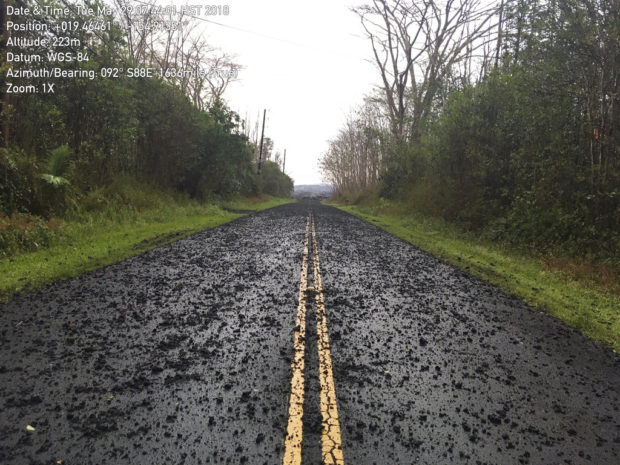Current lava flows are hottest, fastest of Hawaii volcano’s latest eruption

This Tuesday, May 29, 2018 photo provided by the U.S. Geological Survey shows what is known as tephra, airborne lava fragments, erupted by the high lava fountains of fissure 8 was carried downwind, where the frothy rock fragments fell on Leilani Street, just past Kupono Street, in the Leilani Estates subdivision.(U.S. Geological Survey via AP)
HONOLULU — The hottest and fastest-moving lava of Kilauea volcano’s latest eruption spread across new parts of the Big Island on Wednesday, forcing officials to order evacuations in two coastal neighborhoods over fears that the rapidly advancing flows could cut off dwindling escape routes.
Overnight, the lava was moving fast enough to cover about six football fields an hour, according to United States Geological Survey (USGS) scientist Wendy Stovall.
“Hawaii County Civil Defense decided to evacuate all of lower Puna to ensure that people would be able to get out,” Stovall said.
Lava gushed across and then along a roadway that leads from the commercial center of Pahoa toward smaller towns and rural farmlands to the east.
About two dozen new fissures in that area have created towering lava fountains and bone-rattling explosions throughout the eruption. The lava that is currently coming to the surface is the hottest and most fluid to date.
Article continues after this advertisement“This is the hottest lava that we’ve seen in this eruption, even just a matter of 50 degrees centigrade makes a big difference in how quickly lava flows can move and how they behave once the magma exits the vent,” Stovall said.
Article continues after this advertisementIn fact, the current lava eruptions in Puna were as hot as Hawaii’s lava will ever get.
“It can’t get hotter than where we are,” Stovall also said. “We are pretty much tapping mantle temperatures right now.”

In this May 23, 2018 photo provided by Chris Stewart, the sun sets through “vog,” or volcanic smog, in Kailua-Kona, Hawaii. Kilauea volcano on Hawaii’s Big Island has had it all over the past three weeks: molten rock shooting toward the sky, lava oozing from the ground and ash clouds rising miles into the air. You can also add “vog” to the mix. Retired photojournalist Chris Stewart says there’s one good thing about vog: It intensifies the colors of a sunset. But it depends on how thick the haze is. “Some days it’s thin enough you can see the sun passing through,” he said. “But other days we just go inside because we can’t see it at all.” (Chris Stewart via AP)
One fissure was observed early Wednesday morning spouting lava over 200 feet (61 meters) into the air.
Hawaii County officials said lava destroyed the electric utility’s equipment on the highway, which knocked out power to Vacationland and Kapoho Beach Lots.
“You are at risk of being isolated due to possible lava inundation,” the Hawaii County Civil Defense agency advised the public.
There were several small earthquakes at Kilauea’s summit on Wednesday, where the vent inside the volcano’s Halemaumau Crater has grown along with a series of explosive eruptions that have sent rock and ash thousands of feet into the sky.
The USGS released drone footage Wednesday of another fast-moving lava flow that trapped a man in Leilani Estates over the weekend. As lava rushed past the property, a USGS crew that was flying the drone used the aircraft to lead rescue teams to the stranded person. The person was safely evacuated from the area.
Hawaii Volcanoes National Park remains closed because of the volcanic activity at the summit and the ongoing eruptions on Kilauea’s eastern flanks. Park officials said that crews were working on clearing another roadway on the south side of the park that was covered by lava from previous eruptions. They expressed hope that the roadway will provide an alternative escape route if lava cuts off more roads to the north.
Strands of volcanic glass called as Pele’s hair was accumulating on the ground in Leilani Estates and surrounding neighborhoods, and winds may blow lighter particles farther away, scientists said. The strands can cause irritation and respiratory problems when it comes in contact with people.
Volcanic gas emissions remained high from the eruption. Wind conditions for Wednesday were forecast to result in widespread vog — or volcanic smog— over the Big Island. /kga